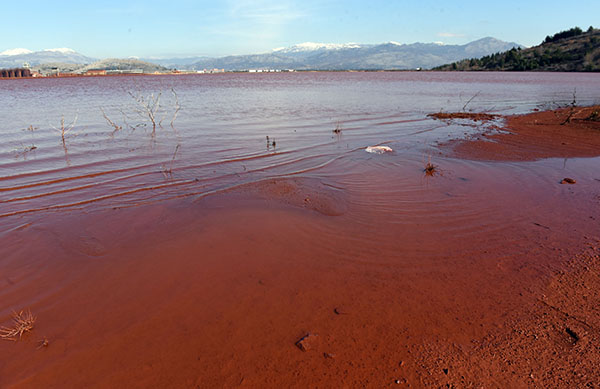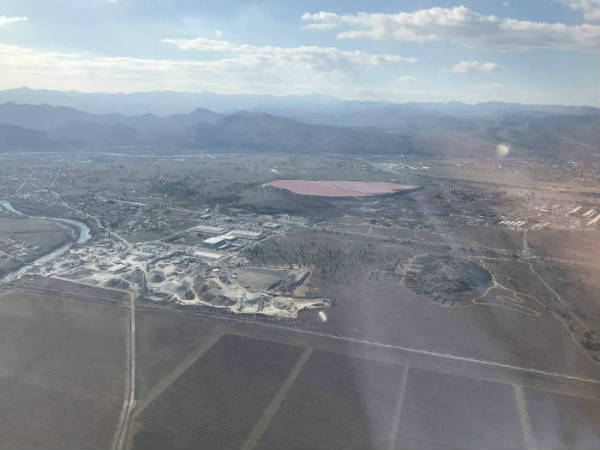BAUXITE TAILINGS MENACE LIFE AS STATE AUTHORITIES STAND IDLY BY: Environmental ticking bomb on the outskirts of the capital city

As funds granted by the World Bank remain unused the government is unmoved by some 7.5 million tonnes of hazardous waste that loom over the country. On the other hand the authorities' response to environmental incidents is merely symbolic whereas ordinary people have to bear the brunt of enormous environmental damage. The Brussels administration is not delighted with the Montenegrin government’s request to postpone tackling ecological problems caused by the aluminum smelter (KAP) for year 2030.
”There’s no future here in the next thousand or so years. The pollution is unbelievable. We can’t drink water here, we can’t grow plants, the underground water courses have been poisoned for 45 years” says Drago Terzic, a resident of Srpska, a village in close proximity to the aluminum plant and its red mud pools. The place is also plagued by piles of garbage and abandoned houses only 9km away from the centre of Montenegro's capital Podgorica. The Aluminum facility was once the prime giant of socialist industry. Its heyday passed long time ago but the consequences remain and are highly visible.
The Bauxite tailings are easily accessible. There is neither security around the place nor warning signs. Two red mud ponds which store around 7.5 million tonnes of hazardous waste are situated next to the smelter. One pond has non-permeable bottom while the other has no leaking barrier thus heavy metals and carcinogens penetrate and poison the underground and the surface waters alike.
Drago Terzic and his first neighbour Boro Lazovic complain that whenever a stronger wind descends it lifts the dust from the ponds and carries it around. They shut themselves in their homes and wait for the wind to cease. They point out that a part of the Moraca River is totally contaminated and without fish.
Dijana Milev Cavor of Green Home NGO warns of the red mud dangers to the environment. Green Home conducted a research on Lake Skadar and its pollution in 2012. The main source of contamination is KAP. The research further states that KAP has generated some 325 thousand tonnes of solid waste which is labeled as hazardous due to high concentration of fluorides, nickel, chromium, copper, cadmium, zinc, arsenic, mercury, cyanide... which have penetrated the soil and underground water courses.
The bauxite residue in its dry form can become airborne by wind and spread over large areas. It can pose a threat to arable land and to human health.
Moreover the Centre for Eco-toxicological Research (CETI) has warned for years about soil and underground water pollution around KAP. The Montenegrin Investigative Reporting Centre's (CIN-CG) findings prove once more that the authorities’ response has been inadequate.
The World Bank granted a loan of €50 million five years ago to solve the problem of KAP’s bauxite tailings and solid waste. However, the project is stuck from the very beginning.
Montenegro’s request to postpone implementation of the EU ecological standards for 11 years is something unheard of so far- Gallop
The deadline for issuing Integrated Pollution Prevention and Control (IPPC) permit to KAP smelter expired on 1 Jan 2018. IPCC permits are one of the conditions for Montenegro-EU accession talks as thereby industrial facilities prove that they adhere to the best techniques of pollution prevention and control.
The Montenegrin authorities are totally unprepared for the said criteria hence they keep trying to obtain concessions from the Brussels administration and push the deadline all the way up to 2030. In the meantime the IPCC implementation has been formally halted under excuse of unresolved property disputes between KAP’s bankruptcy administration and the new Niksic-based owner Uniprom LLC.
The Brussels administration replied our inquiry via Delegation of the EU to Montenegro saying that Montenegro could not change rules and policies of the EU. The European Commission said that Montenegro’s request to postpone the implementation of the IPCC Directive would require “a detailed elaboration before the EU reaches decision (by consensus of all member states)”. Until then Montenegro is expected to comply with and implement the current regulation including the aforesaid directive. “The European Union does acknowledge that Montenegro plans to adopt certain implementation plans in 2019 which are related to the said directive. That is a prerequisite to continue business in the interim periods” says Brussels.
The Ministry of Sustainable Development and Tourism (MORT) told CIN-CG that it requested an interim period in regard to implementation of the IPPC Directive on industrial emissions. MORT cites the examples of other candidate states which lodged similar requests during their accession talks.
An EU expert and an environmentalist of England-based Bankwatch Pippa Gallop says in the interview with CIN-CG that it is entirely unacceptable to postpone the directive implementation till 2030. The standards are relatively high hence no guarantee that Montenegro’s request will be granted.
“I know that Croatia requested to postpone the directive implementation for a couple of years but the Montenegrin request is something unheard of and I see no grounds for such a motion” says Gallop.
Speaking of the World Bank loan she says it’s surprising how little has been done to resolve the issue of the red mud ponds. The plans are frequently changed and the WB evades talking about it.
"On the other hand, the conditions to unlock the loan have not been met while the bank is in no hurry. However, for human and environmental reasons the present situation is unacceptable and we’ll keep pressing them about it” said Gallop
Pollution is "being investigated"
Montenegrin prosecutors in the meantime say they investigate last September and October incidents when the bauxite dust took off from the red mud ponds and contaminated the surrounding area. That was not the first time though. The Podgorica Prosecution Office confirmed to CIN-CG that Environmental Inspectorate and nearby residents lodged complaints “which are being investigated”.
Berane-based company Wag–Kolektor has been the owner of the red mud ponds since Feb 2016. Inspectors asked the company to install a system for sprinkling along the edge of the ponds since the area was not completely covered by irrigation system. The inspectors warned that the present provisions were insufficient to prevent emissions of red dust.
Sinisa Jevric, one of the founders of Wag–Kolektor, in the interview with CIN-CG states that all requests of the inspectorate will be fulfilled by the middle of the year.
On the other hand, the fines for non-compliance are rather jokes. Last October the aforesaid company was fined €300 while the owner nearly got away- he has to pay no more than €30.
The inspectors also investigate whether caustic soda leaked from the aluminum smelter into the Moraca River. However, it has been established that a certain amount of lye ended up in the smelter's sewage system. No good news arrive from there.
Any stronger earthquake could cause red mud to spill
Ana Misurovic, a former CETI executive and a toxicological expert, wrote in 2004 that people living around the aluminum smelter were risking their health by exposure to intoxicants in air, water and food...
The collapse of a dam on much larger bauxite tailings in northern Hungary 9 years ago caused the death of 9 persons while hundreds were injured and a large surrounding area was contaminated.
Misurovic in her interview with CIN-CG reckons that in case of a strong earthquake the red mud could spill out of the basins. She believes that no one has examined the potential threat so far.
Soil and underground waters around KAP were examined by CETI before. CIN-CG obtained CETI’s reports for 2016 and 2017 which stated that no improvement had been made. Physical and chemical analysis made in 2016 confirmed the presence of nitrates, zinc, cyanide, orthophosphate and ammonium above the red line levels in the underground water courses within the smelter's boundary.
CETI also analised the soil around KAP in those years and each report warn about increasing levels of chromium, nickel, fluorine, polycyclic aromatic hydrocarbons...
Environmental Protection Agency came up with similar findings in 2017 and blamed the aluminum smelter for the pollution.
Fishy transactions with red mud basins
OZON NGO director Aleksandar Perovic finds the authorities’ silence on pollution unacceptable and “possibly fatal to the population around KAP smelter”. Perovic criticises the whole thing about the loan granted by the World Bank as nothing has changed in reality. He lists the red mud basins as another example of botched privatisation.
“It made no sense to separate the bauxite tailings, a notorious black spot, from KAP smelter and hand it over to someone else”. The first company which took over the red mud basins had plans to extract the material which could be used in road constructions. “Unfortunately, the investor could not obtain the permits and left. Then the place ended up, under murky circumstances, in the hands of a company which was without any experience in the aforesaid business” says Perovic.
He further claims that it’s a public secret that the only aim of the privatisation is to resell the bauxite tailings to the government so that it becomes a part of KAP again. Thus everyone with fingers in the pie will his handy commission. Perovic is adamant that “the company (Wag-Kolektor) is not capable, both financially and in terms of expertise, to operate the red mud basins”.
However, Wag-Kolektor told CIN-CG that they had plans to restart the red mud procession together with its German partner by the middle of this year. Jevric denied that he had intention to sell the ponds to anyone. Nonetheless he did confirm that he was summoned by a local prosecutor to give a statement about the red dust emission at the end of last year.
MORT- standards must be adhered to regardless of permits
In the 2017 review the government states that KAP’s technology is outdated and incapable of implementing the EU standards in less then 10 years.
“ The issue of KAP is a very complex one. It’s not only a question of environmental and security risks but it comes together with the current bankruptcy protocol, ownership over bauxite tailings so to meet all the criteria set forth by the World Bank...” is stated by MORT.
Polluters to be held accountable
Uniprom hasn’t replied CIN-CG questions on the company’s vision in regard to environmental issues caused by the smelter’s operations and whether and when the company will apply for intergrated permit.
The government recently drafted a bill on industrial emissions which will introduce a new rule- “the polluters shall pay”. The fines will range from €5,000 to €40,000 for legal entities if they operate without permits or if they fail to submit anual reports on the quality of soil, air, water, sea etc.
Maja BORIČIĆ







